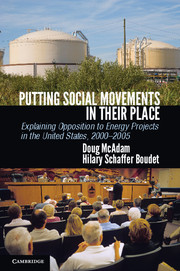 Putting Social Movements in their Place
Putting Social Movements in their Place Book contents
- Frontmatter
- Contents
- Acknowledgments
- 1 From Copernicus to Ptolemy and (Hopefully) Back Again
- 2 Comparing Communities “At Risk” for Mobilization
- 3 Explaining Variation in the Level of Opposition to Energy Projects
- 4 Does Opposition Matter?
- 5 From Not in My Backyard to Not in Anyone’s Backyard
- 6 Back to the Future
- Appendix A Additional Community Data Collected Not Used in Causal and Outcome Condition Scoring
- Appendix B Raw Data and Methods for Scoring Causal Conditions
- Appendix C Interview Sources by Case
- Bibliography
- Index
4 - Does Opposition Matter?
Mobilization and Project Outcome
Published online by Cambridge University Press: 05 June 2012
- Frontmatter
- Contents
- Acknowledgments
- 1 From Copernicus to Ptolemy and (Hopefully) Back Again
- 2 Comparing Communities “At Risk” for Mobilization
- 3 Explaining Variation in the Level of Opposition to Energy Projects
- 4 Does Opposition Matter?
- 5 From Not in My Backyard to Not in Anyone’s Backyard
- 6 Back to the Future
- Appendix A Additional Community Data Collected Not Used in Causal and Outcome Condition Scoring
- Appendix B Raw Data and Methods for Scoring Causal Conditions
- Appendix C Interview Sources by Case
- Bibliography
- Index
Summary
In the previous two chapters we showed that there was considerable variation in mobilization across our twenty communities. In this chapter we turn our attention to the all-important issue of “movement outcomes.” At the heart of the chapter is a single, stark, research question: does the aforementioned variation in mobilization help us understand the ultimate fate of the proposed projects? To answer the question, we look at three different “outcome” measures. The first is whether the project was rejected during the regulatory review process. The second is the opposite of the first, whether the project was approved during the regulatory review process. The third – a very different outcome – is whether the project was ultimately built.
Given the exceedingly modest levels of contention that we found across our cases, we were frankly expecting to see little affect of mobilization/nonmobilization on project outcomes. Taken together, however, our results show a surprisingly strong imprint of mobilization/nonmobilization on the ultimate fate of the projects. Three specific findings bear mention. The strongest relationship is a negative one: the failure of a community to mobilize is, in and of itself, sufficient to explain project approval. Although the converse is not true, mobilization is an important component of the recipes explaining project rejection. The outcome that shows the weakest relationship to mobilization/nonmobilization is whether the project is ultimately built. This makes sense. The decision to build a project depends on a host of factors – most importantly in our cases, the variable health of the relevant energy market at the time of construction – other than level of opposition. Still we will include all three measures in our analysis. But we are getting ahead of ourselves. Before we dig into the data, we want to review the curious history of research – or lack thereof – into this seemingly most important of research questions.
- Type
- Chapter
- Information
- Putting Social Movements in their PlaceExplaining Opposition to Energy Projects in the United States, 2000–2005, pp. 98 - 131Publisher: Cambridge University PressPrint publication year: 2012
- 1
- Cited by
